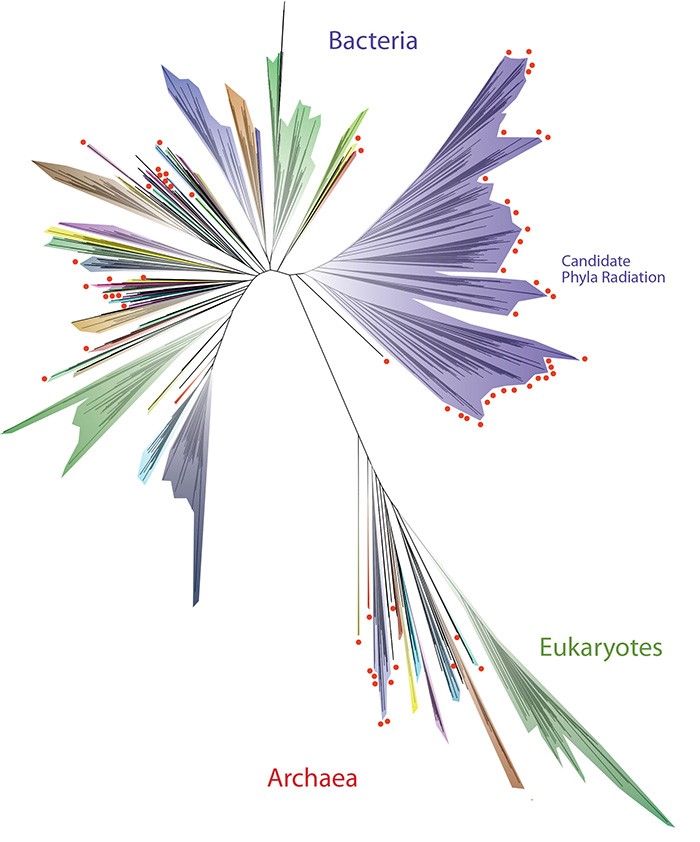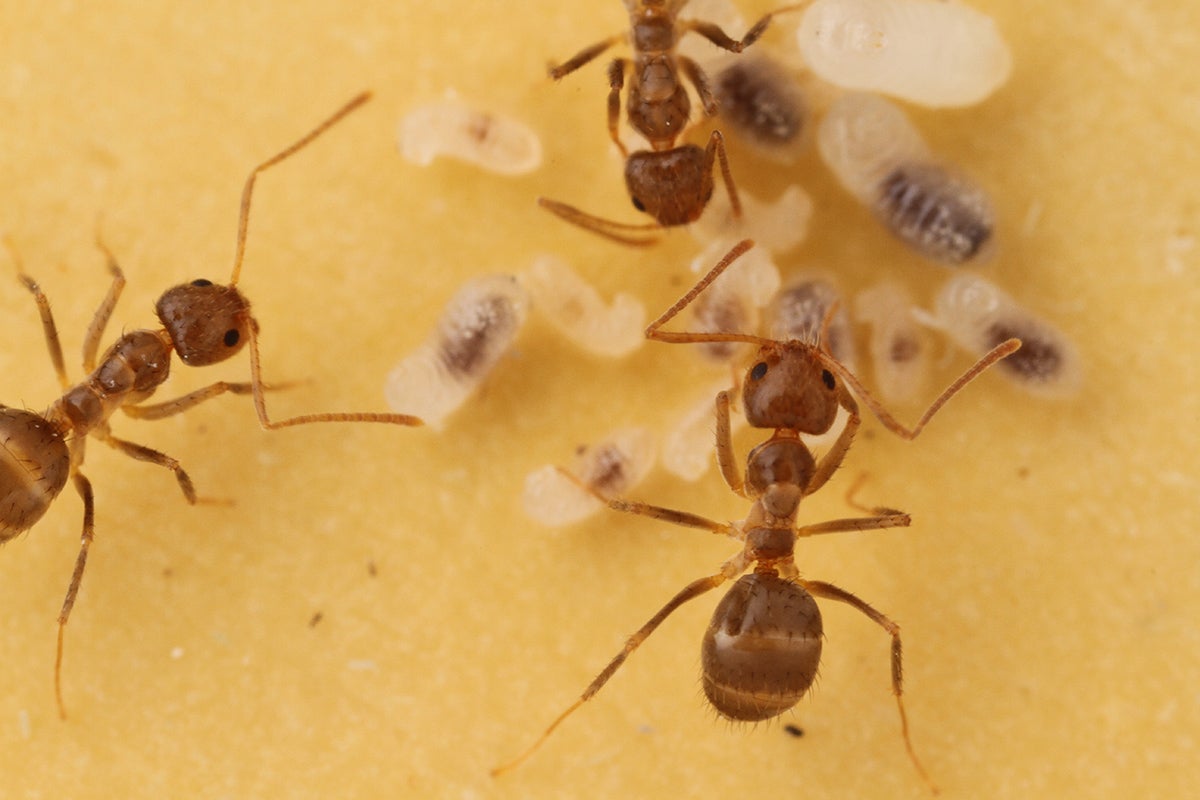Scientists Unveil the Most Comprehensive Genomic Tree of Life
Genetic data reveal a group of bacteria that are so diverse genetically that they represent half of all the diversity of bacteria on the planet

New research suggests that the Tree of Life is vastly different than previously thought. It has dramatically expanded with evidence of new organisms. In this simplified version, each line represents a species and each new species is indicted by a red dot. About one-third of all biodiversity comes from bacteria, one-third from uncultivable bacteria, and a bit less than one-third from Archaea and eukaryotes (including people, plants and animals). High-res version: https://www.flickr.com/photos/utmsi/26231258281/in/shares-E6R79r/
An international team of researchers, including Brett Baker from The University of Texas Marine Science Institute, has made the most comprehensive tree of life based on genomes, greatly expanding our view of the diversity of life on the planet. Using genetic data collected in recent years, the researchers found a group of bacteria that are so diverse genetically that they represent half of all the diversity of bacteria on the planet.
Much of this microbial diversity remained hidden until the genome revolution allowed microbiologists to search directly for new microbes in the environment by analyzing their genomes, rather than culturing them in a lab dish. Less than 0.1 percent of microbes in the world can be cultured, which means there are thousands, maybe even millions, of microbes yet to be discovered. According to Baker, the new technique of using genomes to discover new microorganisms is akin to the invention of the telescope and the proceeding discoveries of new stars and galaxies.
Until recently, most trees of life — which depict how life has evolved and diversified on the planet — were based on physical traits of organisms rather than their genes.
"The tree of life is our central organizing unit of biology," said Assistant Professor Baker. "It's the way we understand relationships amongst all life. Charles Darwin drew trees of what he was seeing in nature, and we now use genetic sequences to draw them."
Scientists have created trees of life that include more species than this latest tree, but those tended to focus disproportionately on plants and animals. This newest tree — incorporating 3,083 organisms, one from each genus for which fully or almost fully sequenced genomes were available — more closely represents the full richness of life on the planet.
"This is the first three-domain genome-based tree to incorporate these uncultivable organisms, and it reveals the vast scope of as yet little known lineages," said research team lead Jill Banfield from the University of California, Berkeley, referring to the three major domains of life: bacteria, Archaea and eukaryotes. "The new depiction will be of use not only to biologists who study microbial ecology, but also biochemists searching for novel genes and researchers studying evolution and Earth history."
The new tree, published online April 11 in the journal Nature Microbiology, reinforces once again that the life we see around us — plants, animals, humans and other eukaryotes — represents a tiny percentage of the world's biodiversity.
According to first author Laura Hug, the more than 1,000 newly reported organisms appearing on the revised tree are from a range of environments including a hot spring in Yellowstone National Park, a salt flat in Chile's Atacama desert, terrestrial and wetland sediments, a sparkling water geyser, meadow soil and the inside of a dolphin's mouth. All of these newly recognized organisms are known only from their genomes.
One striking aspect of the new tree of life is that a group of bacteria described as the "candidate phyla radiation" forms a very major branch. Only recognized recently and seemingly composed only of bacteria with symbiotic lifestyles, the candidate phyla radiation now appears to contain about half of all bacterial evolutionary diversity.
"This incredible diversity means that there are a mind boggling number of organisms that we are just beginning to explore the inner workings of, which could change our understanding of biology," said Baker.
The paper's authors are Laura Hug of the University of Waterloo; Jill Banfield, Karthik Anantharaman, Christopher Brown, Alexander Probst, Cindy Castelle, Cristina Butterfield, Brian Thomas, Alex Hernsdorf, Ronald Amundson and Kari Finstad of the University of California, Berkeley; Brett Baker from The University of Texas Marine Science Institute; Yuki Amano and Kotaro Ise of the Japan Atomic Energy Agency; Yohey Suzuki of the University of Tokyo; Natasha Dudek of the University of California, Santa Cruz; and David Relman of Stanford University.
The research was supported primarily by the Department of Energy (DOE) through Lawrence Berkeley National Laboratory, with metagenomic sequencing by DOE's Joint Genome Institute in Walnut Creek, California.
High-res. image of the new tree of life available at Flickr.
This press release is based on a release by The University of California, Berkeley.
MORE INFO
Charles Darwin first sketched a tree of life in 1837 as he sought ways of showing how plants, animals and bacteria are related to one another. The idea took root in the 19th century, with the tips of the twigs representing life on Earth today, while the branches connecting them to the trunk implied evolutionary relationships among these creatures. A branch that divides into two twigs near the tips of the tree implies that these organisms have a recent common ancestor, while a forking branch close to the trunk implies an evolutionary split in the distant past.
Archaea were first added in 1977 after work showed that they are distinctly different from bacteria, though single-celled like bacteria. A tree published in 1990 by microbiologist Carl Woese was "a transformative visualization of the tree," said Jill Banfield, a researcher at the University of California, Berkeley. With its three domains, it remains the most recognizable today.
With the increasing ease of DNA sequencing in the 2000s, Banfield and others began to sequence whole communities of organisms at once and to pick out the individual groups based on their genes alone. This metagenomic sequencing revealed whole new groups of bacteria and Archaea, many of them from extreme environments such as the toxic puddles in abandoned mines, the dirt under toxic waste sites and the human gut. Some of these had been detected before, but nothing was known about them because they wouldn't survive when isolated in a lab dish.
For the new paper, UT Marine Science Institute's Brett Baker joined Banfield and teamed up with more than a dozen other researchers who have sequenced new microbial species, gathering 1,011 previously unpublished genomes to add to already known genome sequences of organisms representing the major families of life on Earth.
The research team constructed a tree based on 16 separate genes that code for proteins in the cellular machine called a ribosome, which translates RNA into proteins. They included a total of 3,083 organisms, one from each genus for which fully or almost fully sequenced genomes were available.
The analysis, representing the total diversity among all sequenced genomes, produced a tree with branches dominated by bacteria, especially by uncultivated bacteria. A second view of the tree grouped organisms by their evolutionary distance from one another rather than current taxonomic definitions, making clear that about one-third of all biodiversity comes from bacteria, one-third from uncultivable bacteria, and a bit less than one-third from Archaea and eukaryotes.
"The two main take-home points I see in this tree are the prominence of major lineages that have no cultivable representatives and the great diversity in the bacterial domain, most importantly, the prominence of candidate phyla radiation," Banfield said. "The candidate phyla radiation has as much diversity within it as the rest of the bacteria combined."
Related information:
Newfound groups of bacteria are mixing up the tree of life (U.C. Berkeley, June 2015)



